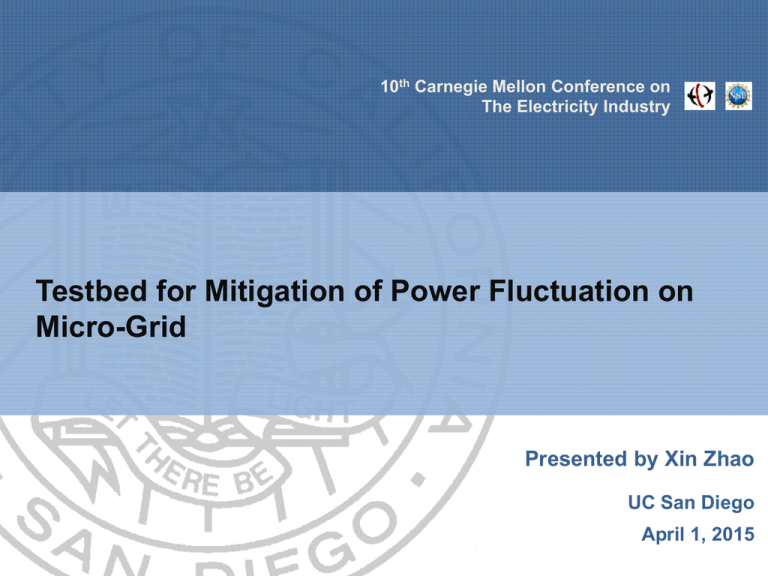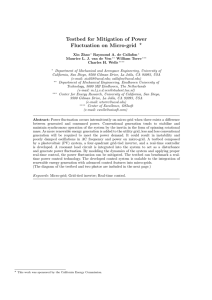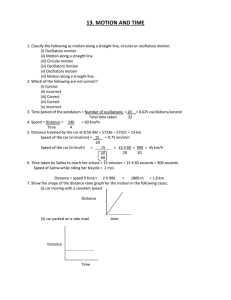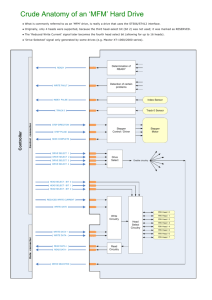Testbed for Mitigation of Power Fluctuation on Micro-Grid Presented by Xin Zhao
advertisement

10th Carnegie Mellon Conference on The Electricity Industry Testbed for Mitigation of Power Fluctuation on Micro-Grid Presented by Xin Zhao UC San Diego April 1, 2015 Acknowledgements The project was sponsored by the California Energy Commission. UC San Diego Team • • • • • Xin Zhao Raymond de Callafon Maurice van de Ven William Torre Chuck Wells System Identification and Control Laboratory, UC San Diego System Identification and Control Laboratory, UC San Diego Eindhoven University of Technology Center for Energy Research, UC San Diego Center for Excellence, OSIsoft OCC Team • • Greg Smedley Tong Chen 2 of 20 One-Cycle Control Inc. One-Cycle Control Inc. Outline • Introduction • Testbed for mitigation of power fluctuation – Overview – “Portable” cabinet – Controller • Preliminary tests on the testbed • Future work 3 of 20 Introduction Introduction Motivation for mitigation of power fluctuation • Power fluctuation occurs intermittently on micro-grid. • Conventional generation tends to stabilize and maintain synchronous operation of the system by the inertia in the form of spinning rotational mass. • As more renewable energy generation is added to the utility grid, it could result in instability and poorly damped oscillations in AC frequency and power on micro-grid. 5 of 20 Introduction Objectives of building a testbed • Simulate a power fluctuation – Motor load – Oscillatory circuitry • Detection of instantaneous fluctuations – Phasor Measurement Unit (PMU) – Instantaneous power sensor • Verification of data-based dynamic modeling (system identification) techniques • Damping controller design and implementation – Embedded devices • Capability of real-time control of an inverter – An inverter with real-time active/reactive power control 6 of 20 Testbed Testbed – Overview System diagram Controller with implementation of instantaneous power calculation and damping control Inverter with real-time control Sensors Controller PV System V V V L1 EMI Filter Grid-Tied Inverter A A L2 A L3 Auxiliary Relay R-L-C Load Circuit Overload Protection Contactor Oscillatory circuitry acting as a power fluctuation 8 of 20 Switch Circuit Breaker GRID Testbed – Key Components “Portable” cabinet Grid-Tied Inverter Controller Cabin Oscillatory R-L-C circuitry 9 of 20 Testbed – Key Components Controller Manufacturer: National Instruments Model: NI myRIO-1900 • • • • • Processor: Memory: Wireless: Analog Input: Analog Output: 10 of 20 Xilinx Z-7010 (Duo Core, 667MHz) (ROM) 256MB (DDR3) 512MB IEEE 802.11 b,g,n 12 bits – 500 kS/s 12 bits – 345 kS/s Preliminary Tests Preliminary Tests Test of simulating power fluctuation • For safety consideration, a programmable DC power supply is installed for testing. • The power fluctuation generated by the oscillatory circuitry is measured and modeled as follows: 100 System Measurement Model Simulation 80 3-phase Real Power 60 40 20 0 -20 -40 12 of 20 1 1.2 1.4 1.6 1.8 2 2.2 Time [sec] 2.4 2.6 2.8 3 Preliminary Tests Four-quadrant grid-tied inverter (GTI) Manufacturer: One-Cycle Control (OCC) Model: GTI3100A6208/3652IR-PQ • • • • • • Max. Power: AC Voltage Range: Rated DC Voltage: Max. AC/DC Current: Weight: Size: 13 of 20 36kW 208V ±10% 365VDC 100Arms / 100A 65lb 23in×17.5in×5.25in Preliminary Tests Capability test of real-time active/reactive power control • Dynamic response of the OCC-GTI is tested with a step control input. • The OCC-GTI is capable to be controlled in real time. 40 30 10 1 0 0 -10 -20 14 of 20 4 4.2 4.4 4.6 4.8 5 5.2 Time (sec) 5.4 5.6 5.8 6 Step Input to GTI Real Power 20 Preliminary Tests Verification of data-based system identification on the GTI output • Based on the measured data obtained by previous tests, a low-order model built within Prediction Error (PE) framework is capable to capture the dynamics. 40 Measured Result Simulated Result 3-phase Real Power 30 20 10 0 -10 -20 15 of 20 4 4.2 4.4 4.6 4.8 5 5.2 Time [sec] 5.4 5.6 5.8 6 Preliminary Tests Verification of data-based system identification on the disturbance • Dynamic response of the oscillatory circuitry is tested. • A low-order model built by Step-Based Realization (SBR) method is capable to capture the dynamics well. 100 Measured Result Simulated Result 80 3-phase Real Power 60 40 20 0 -20 -40 16 of 20 0 0.2 0.4 0.6 0.8 1 1.2 Time [sec] 1.4 1.6 1.8 2 Preliminary Tests Damping control algorithm design and implementation • A preliminary damping control algorithm is designed based on modeling of the system described previously. • The control algorithm is implemented in the controller. Control Algorithm Design Control Algorithm Implementation 120 100 Open-Loop Simulation Closed-Loop Simulation 80 No Control With Feedback Control 100 80 60 3-Phase Real Power 3-Phase Real Power 60 40 20 40 20 0 -20 0 -40 -20 -60 -40 17 of 20 1 1.2 1.4 1.6 1.8 2 2.2 Time [sec] 2.4 2.6 2.8 3 -80 0 0.2 0.4 0.6 0.8 1 1.2 Time [sec] 1.4 1.6 1.8 2 Preliminary Tests Conclusions • The oscillatory circuitry in the testbed is able to simulate a power fluctuation. • The grid-tied inverter provided by One-Cycle Control is capable to be controlled in real time. • The controller is able to process the instantaneous power calculation and realtime control. • The designed control algorithm is able to dampen the oscillation generated by the oscillatory circuitry. 18 of 20 Future Work Future Work Large-scale integration tests • Integration with Phasor Measurement Unit (PMU) • Integration with photovoltaic (PV) systems • Large-scale tests on UCSD micro-grid 20 of 20 Thank you






